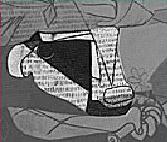Salvador Dali
1943
Dali cryptically wrote "parachute, paranaissance, protection, cupola, placenta, Catholicism, egg, earthly distortion, biological ellipse. Geography changes its skin in historic germination."
Generally it is thought that: The man emerging out of the egg represents the United States, the blood represents World War II, and the man's hand that is on England, possibly indicates that England is in the hands of the United States.
William Blake's term for the entire fallen cosmos is the "mundane shell" -- our egg-shaped world of limited perception that is as comfortable as it is inauthentic.
The parachute, or cloth above and below the egg looks like it was protecting the egg and then was ripped open revealing the egg to woman and child.
The adult is pointing towards the egg in order to educate the child about the events. The shadow of this child is larger possibly indicating that these events have made the child's life significant at that moment and has allowed the child to have a larger stature in the future.
The small background figures that flank the global egg are from Raphael's Marriage of the Virgin (left) and what appears to be a swaying skeleton with a landscape based off studies on John the Baptist (right).

Raphael's Marriage of the Virgin
The Marriage of the Virgin is part of an altarpiece created for a church at Citta di Castello, Italy and shows the marriage of the Virgin Mary and St. Joseph.
Allegory of an American Christmas
Dali used the image of an egg-shaped stone often during the Thirties. As a form that represents a human head, it can be seen in Illumined Pleasures. In the Allegory of an American Christmas, as with the later painting The Metamorphosis of Narcissus, the egg produces the idea of a hatching, or a birth of something new; of a change taking place.
The Metamorphosis of Narcissus
Woman with egg and Arrows 1978






























